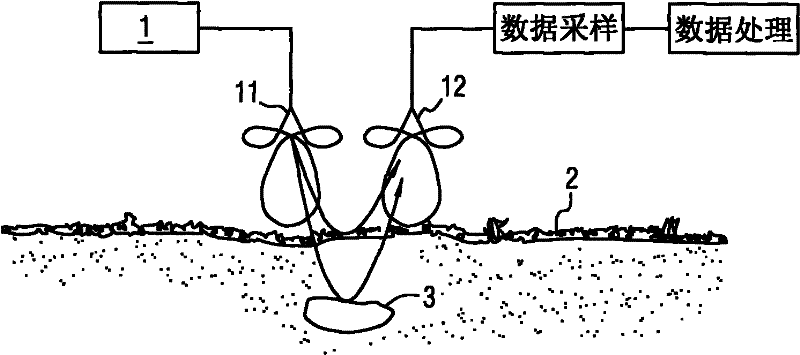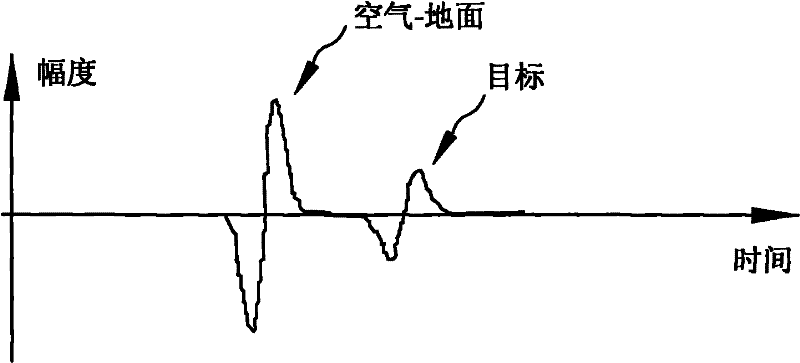Method for measuring biomass of plant underground roots by using ground penetrating radar
A technology of ground penetrating radar and underground roots, applied in the field of measuring the biomass of underground roots of plants
- Summary
- Abstract
- Description
- Claims
- Application Information
AI Technical Summary
Problems solved by technology
Method used
Image
Examples
Embodiment 1
[0032] Embodiment 1 Measurement method
[0033] In the present invention, in order to accurately measure the biomass of plant underground roots, what adopt is the ground-penetrating radar data measurement mode of one-dimensional form, that is, to a given measuring point position of plant underground roots (x i ,y i ), the waveform A(x i ,y i , t), such as figure 2 As shown in , which shows a schematic diagram of a typical monopulse GPR scanning waveform of an underground target. The only variable in the waveform is time. In the subsequent description of the present invention, the data obtained by such scanning is referred to as reflection waveform scanning data.
[0034] From figure 2 The obtained reflection waveform scanning data is a kind of unprocessed data. It can be seen from the figure that the reflection amplitude of the target is much smaller than the reflection amplitude of the air-ground (that is, the ground direct wave). In order to obtain the scanning data ...
Embodiment 2
[0054] Example 2 Measurement of characteristic constant K
[0055] Known by embodiment 1, according to the method for measuring the biomass of underground root of the present invention, the biomass W of plant underground root is and comprehensive index P amp_d Therefore, the characteristic constant K corresponding to the underground roots of a certain plant in a certain area can be obtained by the following method, and then the biomass of the underground roots of this plant in this area can be obtained. The specific method is as follows:
[0056] This underground root after measuring in embodiment 1 is dug out, takes the biomass W of this underground root dug out 1 , the concrete index P of this actually measured plant underground root calculated according to the method in Example 1 amp_d1 , the characteristic constant K=W corresponding to the underground root can be obtained 1 / P amp_d1 .
[0057] That is to say, in the present invention, construct an index P of ground-p...
Embodiment 3
[0060] Embodiment 3 verification test 1
[0061] In the present embodiment, utilize the method for correlation analysis to calculate, the biomass of the actual root that actually measures obtains and three kinds of frequency (2GHz, 900MHz, 500MHz) correspond respectively to the single-pulse reflected wave waveform diagram of the radar wave that extracts Three indices (P max_A , P min_A , P amp_d ) correlation coefficient R and P are shown in Table 1 and Table 2. Table 1 lists the relationship between the fresh biomass of the root and the three indices, and Table 2 lists the relationship between the dry biomass of the root and the three indices.
[0062] Table 1
[0063]
[0064] Table 2
[0065]
[0066] It can be seen from the results in the table that the three indexes corresponding to the three radar wave frequencies have obvious positive correlations with the root biomass, and the correlation coefficient R ranges from 0.63 to 0.93 (Pamp_d Both showed the stronge...
PUM
 Login to View More
Login to View More Abstract
Description
Claims
Application Information
 Login to View More
Login to View More - R&D
- Intellectual Property
- Life Sciences
- Materials
- Tech Scout
- Unparalleled Data Quality
- Higher Quality Content
- 60% Fewer Hallucinations
Browse by: Latest US Patents, China's latest patents, Technical Efficacy Thesaurus, Application Domain, Technology Topic, Popular Technical Reports.
© 2025 PatSnap. All rights reserved.Legal|Privacy policy|Modern Slavery Act Transparency Statement|Sitemap|About US| Contact US: help@patsnap.com



